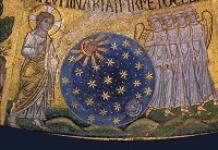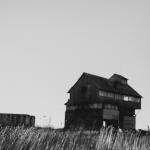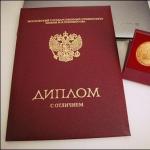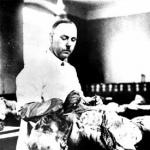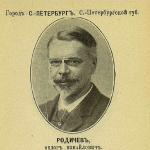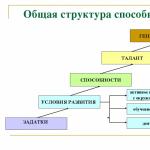(No ratings yet)
 Name: Sergey Alexandrovich Sadov
Name: Sergey Alexandrovich Sadov
Date of Birth: February 27, 1975
Place of Birth: Russia, Samara
Sergei Sadov - biography
Sergei Sadov is a famous contemporary writer working in the fantasy genre. In real life, his name is Sergei Aleksandrovich Didenko, and his creative pseudonym is a combination of initials.
The future author of wonderful books was born on February 27, 1975 in the city of Kuibyshev (now Samara). After graduating from school in 1992, Sergei became a student at Samara State Technical University. Having studied at the Faculty of Automation and Information Technology, the graduate leaves the Alma Mater in 1997 with a diploma in the specialty “Computer systems, systems, machines and networks.” The young man immediately receives a position as a programmer in one of the social centers providing psychological assistance to families and adolescents. Sergei Aleksandrovich admits that dysfunctional families and the fates of unfortunate children impressed him so much that this was reflected in his work - he writes a lot about teenagers - their problems, experiences, difficulties in relationships, achievements and the difficult path to happiness.
In 2001, Sergei decided to leave the social sector and got a new job. Now he administers databases at one of the large state-owned enterprises.
The future writer had a weakness for literature since his school days, and he loved not only to read, but also to write fairy tales and fantastic stories. His first book can be considered the novel “The Wanderer in the Night,” begun in the ninth grade (it was completed after university). Before Sergei Sadov began publishing his works, readers managed to familiarize themselves with some of his works in electronic form. His earliest books include the stories “Through Thorns to...”, “Answer”; the novels “Heir of the Order”, “Knight of Two Worlds”, “Blades at the Throne”, united in the trilogy “Knight of the Order” (this fantastic epic was published by the Eksmo publishing house in 2009).
Sergei made his debut as a printed publication in 2002, when the AST publishing house released a two-volume epic in the fantasy action genre, “The Price of Victory.” Following it, the novels “Woe to the Winners” and “The Case of the Restless Soul” (its other name is “Hellish Practice”) were published. These works “blew up” the readership, the storylines were so original and deep. The main characters of the books are children and teenagers, who are faced with far from childish tasks - to survive in critical conditions, save the entire galaxy from a destructive force, and go through a difficult path, cleansing their souls from Evil.
The author’s next large-scale work was the dilogy “Alvander’s Crystal”, published in 2007 - a combination of utopia and planetary science fiction (the sequence of books in this cycle is “Alvander’s Crystal”, “Alvander’s Ship”). This was followed by the co-author project “Three Roads into Darkness”, created in a creative tandem with Iar Elterrus. In 2008, one of the largest Russian publishing houses, Eksmo, entered into an agreement with the successful writer. Inspired by success and enthusiastic reader reviews, Sergei Sadov creates new storylines, framed by the flavor of science fiction, and also tries his hand at new literary styles. In 2011-2014, a trilogy in the genre of scientific fantasy with detective elements, “The Mysteries of Morigata,” was published, and in 2015, the first part of the fantasy cycle “The Ice Princess,” “The Beginning of the Journey,” was published. By the end of 2016, Sergei Alexandrovich became the owner of more than fifteen printed publications, many of them included in the category of bestsellers. According to the results of the readership rating, the best books of a modern writer include novels in the genre of historical fiction “Leaving to Survive” and “Alien War”, included in the series “Prince Voldemar Starinov”, the two-volume epic “Alvander’s Crystal”, included in the series “ Returned Stars”, the “Knight of the Order” trilogy, the “Three Roads into Darkness” series, the humorous story “The Saga of a Drunken Student”.
All books by Sergei Sadov are distinguished by subtle psychologism, which makes you think about the social problems of society. His stories have fascinating and dynamic plots, bright fantasy worlds are closely related to our everyday life, where teenagers fail to achieve recognition and understanding, and violence, rudeness and hypocrisy have long captured the hearts of adults, making them callous and “blind.” With his work, the author emphasizes that children are the future of our planet and civilization as a whole, that only they can save the world thanks to their sincerity, courage, desire to create and resist the forces of evil almost alone. Many characters in science fiction works are our contemporaries who find themselves in a parallel reality, the past or the future. Sergei Aleksandrovich writes their images very realistically, carefully drawing psychological portraits, showing the emotional state and evolution of growing up as a professional psychologist.
Among literary genres, the Russian writer writes mainly science and planetary fiction, heroic fantasy, historical fiction and chrono-opera, and science fantasy. In his books you can find elements of utopia, detective, action and thriller.
If you are looking for high-quality science fiction literature with powerful psychological and philosophical overtones, we advise you to pay attention to the works of Sergei Sadov. Our online library contains a complete list of the author's works, arranged in chronological order. You can download the writer’s e-books in Russian for free by choosing one of the following formats: fb2 (fb2), txt (tkht), epub, rtf. If you want to read books by Sergei Sadov online, you can also use the materials on our website.
All books by Sergei Sadov
Book series - Knight of the Order
- Heir to the Order
- Knight of Two Worlds
- Blades at the throne
Book series - Returned Stars
- Alvander Crystal
- Alvander's ship
Book series - Three roads into darkness
- Comprehension
- Change
Book series - Morigata Mysteries
- The Riddle of Old Man Greenver
- The Imperial Ambassador's Mystery
- The mystery of the Torey maniac
Book series - New Heroes
- Overcoming
- Ice Princess. The beginning of the way
- Alien war
- Leave to survive
No series
- The case of the restless soul
- The price of victory
- Woe to the winners
- Wanderer in Time
Sergey Sadov(real name - Sergey Alexandrovich Didenko; genus. February 27) - Russian science fiction writer, author of works in the fantasy genre.
Biography
Born in Kuibyshev. The surname Sadov is a pseudonym formed from the initial letters of the first name, patronymic and surname.
Books
- Sadov S. The price of victory. - M.: LLC "AST Publishing House", 2002. - 621, p. - (Star Labyrinth). - 8000 copies.
- Sadov S.- ISBN 5-17-012447-3.
- Sadov S. Woe to the victors. - M.: LLC "AST Publishing House": CJSC NPP "Ermak", 2004. - 494, p. - (Star Boulevard). - 5000 copies.
- Sadov S.- ISBN 5-17-006890-5.
- Sadov S. The case of a restless soul. - M.: AST Publishing House LLC, 2005. - (Star Labyrinth).
- Sadov S. Knight of the Order. Book one. Heir to the Order. - M.: FORUM, 2005. - 468 p. - (Other side). - ISBN 5-8199-0245-9.
- Sadov S. Knight of the Order. Book two. Knight of two worlds. - M.: FORUM, 2006. - 480 p. - (Other side). - ISBN 5-91134-015-1.
- Sadov S. Knight of the Order. Book three. Blades at the throne. - M.: FORUM, 2006. - 608 p. - (Other side). - ISBN 5-91134-038-0.
- Alvander Crystal. - St. Petersburg. : Lenizdat; "Leningrad", 2007. - 512 p. - (Combat fiction). - ISBN 5-289-02510-3. Alvander's ship. - St. Petersburg. : Lenizdat; "Leningrad", 2007. - 544 p. - (Combat fiction). - ISBN 5-289-02544-8.
- Alvander Crystal. - St. Petersburg. : Lenizdat; "Leningrad", 2007. - 512 p. - (Combat fiction). - ISBN 5-289-02510-3. Sadov S., Elterrus I.
- Sadov S. Three roads into darkness. Comprehension. - M.: Eksmo, 2008. - 416 p. - 20,000 copies.
- Sadov S.- ISBN 978-5-699-30235-2.
- Sadov S. Three roads into darkness. Change. - M.: Eksmo, 2009. - 448 p. - 12,000 copies.
- Sadov S.- ISBN 978-5-699-32650-1.
- Sadov S. Hell of a practice. - St. Petersburg: Leningrad publishing house, 2009. - 606 p. - 10,050 copies.
- Sadov S.- ISBN 978-5-9942-0348-4.
- Sadov S. Prince Voldemar Starinov. Book one. "Leave to survive." - M.: Eksmo, 2010. - 608 p. - 12,000 copies.
- ISBN 978-5-699-42395-8.
- Wanderer in time. - M.: Eksmo, 2010. - 384 p. - 20,000 copies.
- - ISBN 978-5-699-44367-3.
- Prince Voldemar Starinov. Book two. "Alien War" - M.: Eksmo, 2010. - 736 p. - 25,000 copies.
- ISBN 978-5-699-45572-0.
The mystery of old man Greenver. - M.: Eksmo, 2011. - 448 p. - (New Heroes). - 18,100 copies.
- ISBN 978-5-699-50449-7.
- The mystery of the imperial ambassador. - M.: Eksmo, 2011. - 416 p. - (New Heroes). - 18,000 copies.
- ISBN 978-5-699-50992-8.
The mystery of the Torey maniac. - M.: Eksmo, 2014. - 352 p. - (New Heroes). - 10,000 copies. - ISBN 978-5-699-69695-6“That’s enough, Marya Nikolaevna,” the husband addressed his wife in a quiet voice, obviously only to justify himself to a stranger. - My sister must have taken it away, otherwise where else would I be? - he added.
- Idol! The villain! – the woman screamed angrily, suddenly stopping crying. “You have no heart, you don’t feel sorry for your brainchild.” Someone else would have pulled it out of the fire. And this is an idol, not a man, not a father. “You are a noble man,” the woman quickly turned to Pierre, sobbing. “It caught fire nearby,” he said to us. The girl screamed: it’s burning! They rushed to collect. They jumped out in what they were wearing... That's what they captured... God's blessing and a dowry bed, otherwise everything was lost. Grab the children, Katechka is gone. Oh my God! Ooo! – and again she began to sob. - My dear child, it burned! burned!
- Where, where did she stay? - said Pierre. From the expression on his animated face, his woman realized that this man could help her.
- Father! Father! – she screamed, grabbing his legs. “Benefactor, at least calm my heart... Aniska, go, you vile one, see her off,” she shouted at the girl, angrily opening her mouth and with this movement showing off her long teeth even more.
“Show me off, show me off, I’ll... I’ll... I’ll do it,” Pierre said hastily in a breathless voice.
The dirty girl came out from behind the chest, tidied up her braid and, sighing, walked forward along the path with her blunt bare feet. Pierre seemed to suddenly come to life after a severe faint. He raised his head higher, his eyes lit up with the sparkle of life, and he quickly followed the girl, overtook her and went out onto Povarskaya. The entire street was covered in a cloud of black smoke. Tongues of flame burst out here and there from this cloud. A large crowd of people crowded in front of the fire. A French general stood in the middle of the street and said something to those around him. Pierre, accompanied by the girl, approached the place where the general stood; but French soldiers stopped him.
“On ne passe pas, [They don’t pass here,”] a voice shouted to him.
- Here, uncle! - said the girl. - We'll go through the Nikulins along the alley.
Pierre turned back and walked, occasionally jumping up to keep up with her. The girl ran across the street, turned left into an alley and, after passing three houses, turned right into the gate.
“Right here now,” said the girl, and, running through the yard, she opened the gate in the plank fence and, stopping, pointed to Pierre a small wooden outbuilding that burned brightly and hotly. One side of it collapsed, the other was burning, and the flames were shining brightly from under the window openings and from under the roof.
When Pierre entered the gate, he was overcome with heat, and he involuntarily stopped.
– Which, which is your house? - he asked.
- Oh oh oh! - the girl howled, pointing to the outbuilding. “He’s the one, she’s the one who was our very own.” You burned, my treasure, Katechka, my beloved young lady, oh, oh! - Aniska howled at the sight of the fire, feeling the need to express her feelings.
Pierre leaned towards the outbuilding, but the heat was so strong that he involuntarily described an arc around the outbuilding and found himself next to a large house, which was still burning only on one side of the roof and around which a crowd of French were swarming. Pierre at first did not understand what these French were doing, carrying something; but, seeing in front of him a Frenchman who was beating a peasant with a blunt cleaver, taking away his fox fur coat, Pierre vaguely understood that they were robbing here, but he had no time to dwell on this thought.
The sound of the crackling and roar of collapsing walls and ceilings, the whistle and hiss of flames and the animated cries of the people, the sight of wavering, now scowling thick black, now soaring lightening clouds of smoke with sparkles and sometimes solid, sheaf-shaped, red, sometimes scaly golden flame moving along the walls , the sensation of heat and smoke and the speed of movement produced on Pierre their usual stimulating effect of fires. This effect was especially strong on Pierre, because Pierre suddenly, at the sight of this fire, felt freed from the thoughts that were weighing him down. He felt young, cheerful, agile and determined. He ran around the outbuilding from the side of the house and was about to run to the part of it that was still standing, when a cry of several voices was heard above his head, followed by the cracking and ringing of something heavy that fell next to him.
Pierre looked around and saw the French in the windows of the house, who had thrown out a chest of drawers filled with some kind of metal things. Other French soldiers below approached the box.
“Eh bien, qu"est ce qu"il veut celui la, [This one still needs something," one of the French shouted at Pierre.
- Un enfant dans cette maison. N"avez vous pas vu un enfant? [A child in this house. Have you seen the child?] - said Pierre.
– Tiens, qu"est ce qu"il chante celui la? Va te promener, [What else is this interpreting? “Get to hell,” voices were heard, and one of the soldiers, apparently afraid that Pierre would take it into his head to take away the silver and bronze that were in the box, advanced threateningly towards him.
- Un enfant? - the Frenchman shouted from above. - J"ai entendu piailler quelque chose au jardin. Peut etre c"est sou moutard au bonhomme. Faut etre humain, voyez vous... [Child? I heard something squeaking in the garden. Maybe it's his child. Well, it is necessary according to humanity. We all people…]
Husband of Grand Duchess Elizabeth Feodorovna. Killed by terrorist Kalyaev's bomb.
Biography
Participant in the Russian-Turkish War of 1877-1878.
Since February 1887 - commander of the Life Guards Preobrazhensky Regiment.
Since February 26, 1891, Moscow military governor-general; from 1896 commander of the Moscow Military District (lieutenant general).
Since 1892, an honorary member of the Berlin Orthodox Holy Prince Vladimir Brotherhood, which is under the patronage of Grand Duke Vladimir Alexandrovich.
In 1892, the grand opening and consecration of the Moscow City Duma building on Voskresenskaya Square took place; at the end of the same year, elections of councilors were held under the new “City Regulations”.
During his General Government, the Highest Order was issued on October 15, 1892: “retired Jews of the lower ranks who served under the previous recruitment, and members of their families assigned to the cities of the internal provinces, as well as those who, upon retirement, were not yet assigned “to any society,” registration to tax societies and inclusion in the craft guilds of Moscow and the Moscow province was prohibited; the above-mentioned persons, as well as “those assigned to societies in the Jewish Pale of Settlement,” were prohibited from both temporary and permanent residence in Moscow and the Moscow province - in accordance with the general rules established for the temporary stay of Jews outside the Jewish Pale of Settlement (i.e. in accordance with Article 157 of the “Charter on Passports and Fugitives”); The order ordered all listed categories of Jews, “who will find themselves living in Moscow and the Moscow province by the time these rules are issued, to be removed, along with members of their families, from the named areas, within a time frame determined in each individual case, by mutual agreement of the Moscow Governor-General and the Minister of Internal Affairs"; These restrictions did not apply to Jews from the retired lower ranks, already assigned to the petty-bourgeois societies of Moscow and the province, as well as those who joined the eternal craft guilds.
To create normal living conditions for students coming to Moscow, Sergei Alexandrovich raised the issue of organizing dormitories at Moscow University. The first building of the hostel was opened in 1899, the second - in 1903. In 1893, the construction of a new stage of the Mytishchi water supply system was completed. In 1899, trams were added to the city transport fleet. The Museum of Moscow Municipal Economy was opened in 1896, and the Public Art Theater was opened in 1898. On the initiative of Sergei Alexandrovich, the creation of a portrait gallery of former Moscow governors-general began in 1892. A gloomy episode of the reign of Sergei Alexandrovich was the disaster on the Khodynskoye field. According to official data, 1,389 people died in the catastrophic stampede. and 1,300 were seriously injured. The criminal negligence of the tsarist authorities caused public outrage in Russia. The government carried out an investigation, the Moscow chief of police and a number of minor officials were removed. The main culprit of “Khodynka” was the Moscow Governor-General, Grand Duke Sergei Alexandrovich (nicknamed “Prince Khodynsky”) in the same 1896, who was appointed commander of the troops of the Moscow Military District.
He supported government trade unions (Zubatovism) and monarchist organizations, and was an opponent of the revolutionary movement. Chief of Police D.F. Trepov had a great influence on the situation in Moscow after 1896. The Grand Duke was a resolute opponent of constitutional changes. He opposed the attempts of the Minister of Internal Affairs P. D. Svyatopolk-Mirsky to introduce popular representation in Russia. In December 1904, he convinced Nicholas II to delete the clause on “elected representatives of the population” from the highest decree. After the Events of January 9, 1905, the opposition declared Sergei Alexandrovich and his brother Vladimir Alexandrovich the main culprits in the use of military force. Windows were broken in Sergei Alexandrovich's palace in St. Petersburg. The militant organization of the Socialist Revolutionary Party pronounced a “death sentence” on him.
On January 1, 1905, he left the post of Moscow Governor-General, but remained at the head of the district troops, becoming the Commander-in-Chief of the Moscow Military District.
He was one of the initiators of the creation and from May 21, 1882 a founding member, and from April 24, 1889 until his death - Chairman of the Orthodox Palestine Society; from 1881, after the death of Emperor Alexander III, honorary chairman of the board of the Imperial Russian Historical Museum.
In accordance with his position (as one of the senior members of the Imperial family), he was president, chairman, member or benefactor of many scientific societies and organizations: the Moscow Architectural Society, the Ladies' Guardianship of the Poor in Moscow, the Moscow Theological Academy, the Moscow Philharmonic Society, the Committee for the Organization of Moscow University Museum of Fine Arts named after Emperor Alexander III, Moscow Archaeological Society, and was also an honorary member of the Academy of Sciences, Academy of Arts, Society of Artists of Historical Painting, Moscow and St. Petersburg Universities, Moscow Archaeological Society, Society of Agriculture, Society of Natural History Lovers, Russian Musical Society , the Archaeological Museum in Constantinople and the Historical Museum in Moscow, as well as the Moscow Theological Academy, the Orthodox Missionary Society, the Department for the Distribution of Spiritual and Moral Books.
Murder and burial
On February 4, 1905, at about 3 o'clock in the afternoon, the Grand Duke drove off in a carriage from the Nicholas Palace in the Kremlin; when approaching the Nikolskaya Tower, he was torn apart by a “hellish machine” thrown by a member of the “Combat Organization of the Socialist Revolutionary Party” Ivan Kalyaev; died immediately, the coachman was mortally wounded, and the carriage was blown apart. The body of the Grand Duke was dismembered into pieces by the explosion; After embalming and freezing, the remains were placed in a coffin, which was placed in the cathedral of the Kremlin Cathedral Chudov Monastery. From telegrams from Moscow on February 8: “The Kremlin is crowded with people all day. Requiem services are continuously served at the tomb of the Grand Duke. The Church of St. Alexis, in which the coffin with the remains of the Grand Duke is placed, cannot accommodate everyone who wants to venerate the ashes.<…>" The wounded coachman Andrei Rudinkin was taken to the Yauza hospital, where he soon died; his name was also commemorated at the Highest Memorial Service on the evening of February 8, which was led by Metropolitan Vladimir (Epiphany) of Moscow amid general sobbing of the pilgrims.
The funeral service, according to the highest approved ceremony, was performed on February 10, 1905 in the Alekseevskaya Church of the Chudov Monastery in the Kremlin by Metropolitan Vladimir (Epiphany) of Moscow, concelebrated by vicars; the Emperor and Empress were not present. The latter were present in the morning of the same day at the funeral service in the cathedral of the Great Tsarskoye Selo Palace. Newspaper reports from Moscow on the day of the funeral said: “Despite it being a weekday, crowds of thousands strive to the Kremlin to pay their last respects and bow to the ashes of the martyred Grand Duke. As a sign of mourning, some shops are closed, and mourning flags with white pleres fly at the Governor General's house. In front of the Kremlin gates, a reverent crowd formed living trellises<…>" In his word of consolation to Elisaveta Feodorovna before the service, Metropolitan Vladimir called the Grand Duke a “martyr.”
Unlike all the other great princes who died during the reign of Nicholas II, he was not buried in the Peter and Paul Cathedral in St. Petersburg (or the New Tomb with it); his remains were soon interred in a temple-tomb built under the Alekseevsky Cathedral of the Chudov Monastery, demolished in 1930 (in 1995 they were discovered during excavations in the Kremlin and transferred to the Novospassky Monastery).
It is known that on February 7, Grand Duchess Elizabeth visited her husband’s killer, terrorist Ivan Kalyaev, in prison and forgave him on behalf of her husband. V. F. Dzhunkovsky, who collaborated with the prince for many years, wrote about this: “She, by her nature, is all-forgiving, felt the need to say a word of consolation to Kalyaev, who so inhumanly took her husband and friend away from her.” Having learned that Kalyaev was a believer, she gave him the Gospel and a small icon, calling him to repentance. She asked the Emperor to pardon the killer.
The murder of Grand Duke Sergei shocked conservative-monarchist circles of society. He was condemned by the leader of the Irish terrorists, Michael Dewilt, who met with the Grand Duke in Moscow shortly before the tragedy. He told the press that the late Governor-General was "a humane man and had a constant interest in improving the lives of the working people." In left-wing radicals and Jews, on the contrary, the news was greeted with satisfaction, as evidenced by the cynical joke of the time: “Finally, the Grand Duke had to use his brains!”
On April 2, 1908, at the site of the death of Sergei Alexandrovich in the Kremlin, a monument-cross, designed by V. M. Vasnetsov, was consecrated and unveiled; the monument was demolished on May 1, 1918, and V.I. Lenin personally participated in the demolition of the cross. After the remains of the Grand Duke were transferred to the Novospassky Monastery, a cross-monument was recreated there in 1998 according to the sketches of V. M. Vasnetsov (designed by D. Grishin, sculptor N. Orlov).
Personal life and opinions about him
Marriage and family
On June 3 (15), 1884, in the Court Church of the Winter Palace, he married Princess Elizabeth Alexandra Louise Alice of Hesse-Darmstadt, who in Orthodoxy received the name Elisaveta Feodorovna. The latter was the second daughter of the Grand Duke of Hesse Ludwig IV, the granddaughter of Queen Victoria of England and the elder sister of Empress Alexandra Feodorovna, the wife of Nicholas II.
The family of Sergei and Elizabeth brought up Grand Duchess Maria Pavlovna and her brother, Grand Duke Dmitry Pavlovich, whose mother died in premature birth. After the murder of her husband, leaving secular life, Elizaveta Feodorovna became a monk and was subsequently canonized as a martyr killed by the Bolsheviks.
According to the life of the Venerable Martyr Elizabeth, compiled in 1992 (after her canonization), the spouses, independently of each other, even before meeting, took a vow of virginity to God. Therefore, their marriage was childless, they lived like brother and sister.
Charlotte Zeepwat, a representative of Western European pro-monarchist historiography, writes:
The researcher believes that
Homosexuality
Sociologist, psychologist and sexologist Igor Kon argued (1997) that Sergei Alexandrovich led an openly homosexual lifestyle, citing as an example a story from the memoirs of Foreign Minister Count Vladimir Lamsdorf. Historian V. Balyazin noted: “Their family life did not work out, although Elizaveta Feodorovna carefully hid it, not even admitting it to her Darmstadt relatives. The reason for this, in particular, was Sergei Alexandrovich’s addiction to persons of the opposite sex.” The owner of the capital's high society salon, the wife of General E. Bogdanovich, A. V. Bogdanovich, relayed in her diary the words of a Tsarskoye Selo friend that “Sergei Alexandrovich lives with his adjutant Martynov, that he repeatedly suggested to his wife that she choose a husband from the people around her. She saw a foreign newspaper, where it was printed that le grand duc Serge avec sa maitresse m-r un tel had arrived in Paris. Just think, what scandals!” Nina Berberova, in her biography of a contemporary of Prince composer P. I. Tchaikovsky, known for his unconventional orientation, mentioned the following episode: “There is one known case with a person familiar to quite a few, a teacher of Latin and Greek, lover of the Moscow governor, led. book Sergei Alexandrovich (the brother of Alexander the Third), who was tried and given three years of “exile” in Saratov, and then returned to Moscow.”
The opinions of a number of contemporaries and some researchers about the nature of the Grand Duke’s personal life complement their assessments of his political activities. Thus, the American author Virginia Coles, speaking about what she considers Emperor Alexander III and Grand Duke Sergei to be anti-Semitic, called the latter “a sadist and a homosexual.” A member of the State Duma of the first convocation, cadet V.P. Obninsky, wrote about him in the work “The Last Autocrat” (1912), anonymously published by a German publishing house: “This dry, unpleasant man, who even then influenced his young nephew, bore on his face sharp signs of the vice that consumed him , who made the family life of his wife, Elisaveta Feodorovna, unbearable and led her, through a series of hobbies natural in her position, to monasticism.” Obninsky, drawing a panorama of the decomposition of the ruling elite and the armed forces of Russia, also argued: “Many famous people of St. Petersburg, actors, writers, musicians, and grand dukes, also indulged in shameful vice. Their names were on everyone’s lips, many advertised their way of life.<…>It was also curious that not all guard regiments suffered from the vice. At that time, for example, when the Preobrazhensky soldiers devoted themselves to him, together with their commander, almost without exception, the life hussars were distinguished by their naturalness in their affections.”
Throughout his life, Sergei Alexandrovich was very close and friendly with his cousin, Grand Duke Konstantin Konstantinovich, whose diary entries contain references to homosexual contacts.
Information about the sexual preferences of Sergei Alexandrovich is not considered reliable by everyone, and among a number of monarchist-minded Orthodox Christians there is a movement for the canonization of the prince and even his “icons” are being painted.
Contemporary assessments
The court official, General A. A. Mosolov, in his memoirs in Russian, says nothing about the personal life of the Grand Duke: “Very tall, very thoroughbred beauty and extremely elegant, he gave the impression of an exceptionally cold person.<…>The officers of the Preobrazhensky Regiment, which he commanded for many years, loved His Highness very much. The Emperor treated him with obvious respect, but, apparently, there was no particular intimacy between uncle and nephew, although they were married to two sisters, who were also very friendly. Sympathy led. The prince was inclined towards extremely reactionary trends, but his influence on the emperor did not affect.”
Review of him by Grand Duke Alexander Mikhailovich in emigrant memoirs: “Grand Duke Sergei Alexandrovich played a fatal role in the fall of the Empire and was partly responsible for the disaster during the celebration of the coronation of Nicholas II on the Khodynka field in 1896. With all my desire to find at least one positive trait in his character, I cannot find it. Being a very mediocre officer, he nevertheless commanded the L. Guards. Preobrazhensky Regiment - the most brilliant regiment of the Guards Infantry. Completely ignorant in matters of internal government, Grand Duke Sergei was nevertheless the Moscow Governor-General, a post that could only be entrusted to a statesman of very great experience. Stubborn, impudent, unpleasant, he flaunted his shortcomings, as if throwing a challenge in the face of everyone and thus giving his enemies rich food for slander and slander.<…>Emperor Nicholas II should not have allowed Grand Duke Sergei to retain his post as governor-general after the disaster on the Khodynka Field. As if to further emphasize his unpleasant personality, he married the elder sister of the Empress Grand Duchess Elisaveta Feodorovna. It was difficult to imagine a greater contrast than between these two spouses!”
In literature
- Introduced in B. Akunin’s novels “State Councilor” and “Coronation, or the Last of the Romanovs” under the name of Simeon Alexandrovich.
